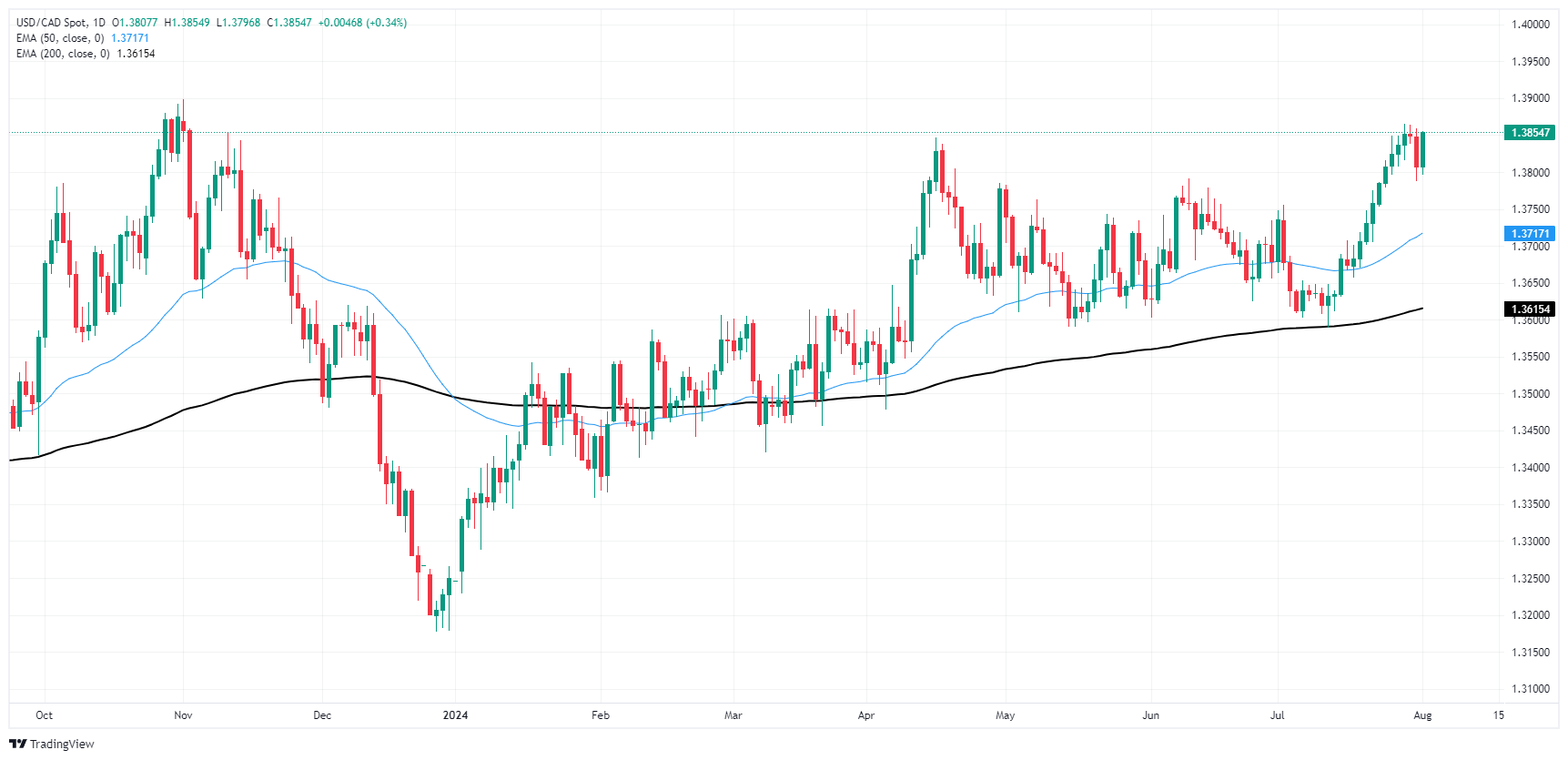- The Canadian Dollar stumbled against the Greenback on Thursday.
- Canada and US PMIs gave a soft print in July.
- US NFP looms large on Friday, markets hoping for continued softening.
The Canadian Dollar (CAD) tripped and fell against the US Dollar (USD) on Thursday after a misprint in Purchasing Managers Index (PMI) figures flashed warning signs of lurking recession risk in the data, sparking a fresh round of risk-off market sentiment. Market flows reversed direction as investors pulled out of alpha-seeking instruments and piled into safe-haven assets like the Greenback.
Canada will fall by the wayside as economic data remains limited until next week’s Canadian labor figures, and markets will be entirely focused on this Friday’s upcoming US Nonfarm Payrolls (NFP).
Markets continue to walk along an incredibly sharp knife edge of hoping for bad economic data that will kick off a rate-cutting cycle from the Federal Reserve (Fed), but not so bad that a broad economic slowdown might render rate cuts pointless.
Daily digest market movers: Canadian Dollar loses market focus as US data dominates
- July’s Canadian S&P Global Manufacturing PMI tumbled to a seven-month low of 47.8 from the previous 49.3 as Canadian manufacturing activity continues to decline.
- The US ISM Manufacturing PMI for the same period also declined to an eight-month low of 46.8 from the previous 48.5, entirely missing the forecast uptick to 48.8 and reigniting concerns of a “hard landing” economic scenario.
- US ISM Manufacturing Prices Paid also accelerated again in July, rising to 52.9 from the previous 52.1 and reversing the forecast move down to 51.8 as inflationary pressures at the front end of the input cycle continue to churn.
- US Initial Jobless Claims also rose more than expected for the week ended July 26, rising to 249K week-on-week compared to the previous 235K, accelerating past the forecast 236K.
- Friday’s US NFP labor data dump is expected to show another slowing in US hiring, with net job gains forecast to print at 175K compared to the previous 206K.
Canadian Dollar PRICE Today
The table below shows the percentage change of Canadian Dollar (CAD) against listed major currencies today. Canadian Dollar was the strongest against the British Pound.
| USD | EUR | GBP | JPY | CAD | AUD | NZD | CHF | |
|---|---|---|---|---|---|---|---|---|
| USD | 0.38% | 0.77% | -0.04% | 0.34% | 0.46% | -0.10% | -0.49% | |
| EUR | -0.38% | 0.39% | -0.44% | -0.05% | 0.09% | -0.48% | -0.87% | |
| GBP | -0.77% | -0.39% | -0.82% | -0.43% | -0.29% | -0.86% | -1.25% | |
| JPY | 0.04% | 0.44% | 0.82% | 0.38% | 0.51% | -0.11% | -0.48% | |
| CAD | -0.34% | 0.05% | 0.43% | -0.38% | 0.14% | -0.44% | -0.83% | |
| AUD | -0.46% | -0.09% | 0.29% | -0.51% | -0.14% | -0.57% | -0.96% | |
| NZD | 0.10% | 0.48% | 0.86% | 0.11% | 0.44% | 0.57% | -0.39% | |
| CHF | 0.49% | 0.87% | 1.25% | 0.48% | 0.83% | 0.96% | 0.39% |
The heat map shows percentage changes of major currencies against each other. The base currency is picked from the left column, while the quote currency is picked from the top row. For example, if you pick the Canadian Dollar from the left column and move along the horizontal line to the US Dollar, the percentage change displayed in the box will represent CAD (base)/USD (quote).
Technical analysis: USD/CAD rises back into 1.3850 in near-term risk-off bid
The Canadian Dollar (CAD) is broadly lower on Thursday, finding thin gains against the Pound Sterling (GBP) and the Australian Dollar (AUD), but shedding weight against the US Dollar and the Japanese Yen (JPY). The CAD is down around one-third of one percent against the Greenback and the Yen, while gaining roughly four-tenths of one percent against the weakening GBP.
The Canadian Dollar’s reprieve from topside US Dollar pressure is set to be a brief one as USD/CAD bids resume a steady push into the high side. The pair is testing back into the 1.3850 region after a mid-week dip below 1.3800. USD/CAD is testing close to 2024’s high bids, set at 1.3865. Continued bullish pressure will set the pair up for a fresh challenge of last October’s swing high into the 1.3900 handle.
USD/CAD daily chart
Canadian Dollar FAQs
The key factors driving the Canadian Dollar (CAD) are the level of interest rates set by the Bank of Canada (BoC), the price of Oil, Canada’s largest export, the health of its economy, inflation and the Trade Balance, which is the difference between the value of Canada’s exports versus its imports. Other factors include market sentiment – whether investors are taking on more risky assets (risk-on) or seeking safe-havens (risk-off) – with risk-on being CAD-positive. As its largest trading partner, the health of the US economy is also a key factor influencing the Canadian Dollar.
The Bank of Canada (BoC) has a significant influence on the Canadian Dollar by setting the level of interest rates that banks can lend to one another. This influences the level of interest rates for everyone. The main goal of the BoC is to maintain inflation at 1-3% by adjusting interest rates up or down. Relatively higher interest rates tend to be positive for the CAD. The Bank of Canada can also use quantitative easing and tightening to influence credit conditions, with the former CAD-negative and the latter CAD-positive.
The price of Oil is a key factor impacting the value of the Canadian Dollar. Petroleum is Canada’s biggest export, so Oil price tends to have an immediate impact on the CAD value. Generally, if Oil price rises CAD also goes up, as aggregate demand for the currency increases. The opposite is the case if the price of Oil falls. Higher Oil prices also tend to result in a greater likelihood of a positive Trade Balance, which is also supportive of the CAD.
While inflation had always traditionally been thought of as a negative factor for a currency since it lowers the value of money, the opposite has actually been the case in modern times with the relaxation of cross-border capital controls. Higher inflation tends to lead central banks to put up interest rates which attracts more capital inflows from global investors seeking a lucrative place to keep their money. This increases demand for the local currency, which in Canada’s case is the Canadian Dollar.
Macroeconomic data releases gauge the health of the economy and can have an impact on the Canadian Dollar. Indicators such as GDP, Manufacturing and Services PMIs, employment, and consumer sentiment surveys can all influence the direction of the CAD. A strong economy is good for the Canadian Dollar. Not only does it attract more foreign investment but it may encourage the Bank of Canada to put up interest rates, leading to a stronger currency. If economic data is weak, however, the CAD is likely to fall.
Information on these pages contains forward-looking statements that involve risks and uncertainties. Markets and instruments profiled on this page are for informational purposes only and should not in any way come across as a recommendation to buy or sell in these assets. You should do your own thorough research before making any investment decisions. FXStreet does not in any way guarantee that this information is free from mistakes, errors, or material misstatements. It also does not guarantee that this information is of a timely nature. Investing in Open Markets involves a great deal of risk, including the loss of all or a portion of your investment, as well as emotional distress. All risks, losses and costs associated with investing, including total loss of principal, are your responsibility. The views and opinions expressed in this article are those of the authors and do not necessarily reflect the official policy or position of FXStreet nor its advertisers. The author will not be held responsible for information that is found at the end of links posted on this page.
If not otherwise explicitly mentioned in the body of the article, at the time of writing, the author has no position in any stock mentioned in this article and no business relationship with any company mentioned. The author has not received compensation for writing this article, other than from FXStreet.
FXStreet and the author do not provide personalized recommendations. The author makes no representations as to the accuracy, completeness, or suitability of this information. FXStreet and the author will not be liable for any errors, omissions or any losses, injuries or damages arising from this information and its display or use. Errors and omissions excepted.
The author and FXStreet are not registered investment advisors and nothing in this article is intended to be investment advice.
Recommended content
Editors’ Picks

EUR/USD challenges 1.0500 on Dollar's bounce
The US Dollar now picks up further pace and weighs on the risk-associated assets, sending EUR/USD to the boundaries of the key 1.0500 region and at shouting distance from its 2024 lows.

GBP/USD remains weak and puts 1.2600 to the test
GBP/USD remains on the back foot and now approaches the key support at 1.2600 the figure in response to the resurgence of the bid bias in the Greenback.

Gold faces extra upside near term
Gold extends its bullish momentum further above $2,660 on Thursday. XAU/USD rises for the fourth straight day, sponsored by geopolitical risks stemming from the worsening Russia-Ukraine war. Markets await comments from Fed policymakers.

BTC hits an all-time high above $97,850, inches away from the $100K mark
Bitcoin hit a new all-time high of $97,852 on Thursday, and the technical outlook suggests a possible continuation of the rally to $100,000. BTC futures have surged past the $100,000 price mark on Deribit, and Lookonchain data shows whales are accumulating.

A new horizon: The economic outlook in a new leadership and policy era
The economic aftershocks of the COVID pandemic, which have dominated the economic landscape over the past few years, are steadily dissipating. These pandemic-induced economic effects are set to be largely supplanted by economic policy changes that are on the horizon in the United States.

Best Forex Brokers with Low Spreads
VERIFIED Low spreads are crucial for reducing trading costs. Explore top Forex brokers offering competitive spreads and high leverage. Compare options for EUR/USD, GBP/USD, USD/JPY, and Gold.